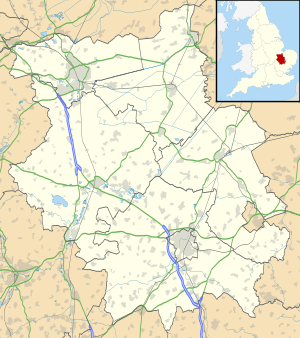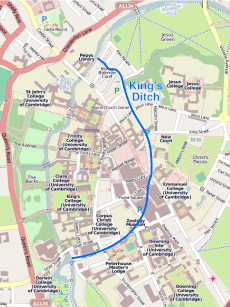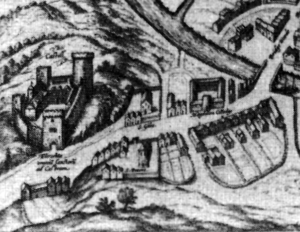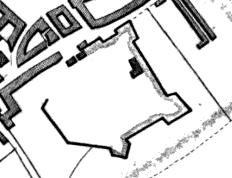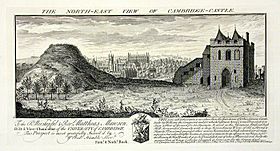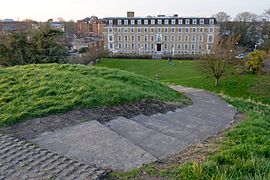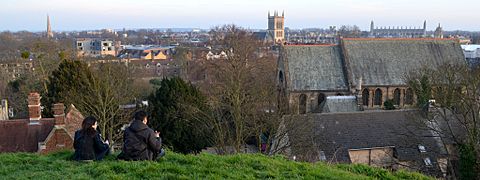Cambridge Castle facts for kids
Quick facts for kids Cambridge Castle |
|
|---|---|
| Cambridgeshire, England | |

Castle Mound today
|
|
| Coordinates | 52°12′43″N 0°06′53″E / 52.2120°N 0.1147°E |
| Type | Motte and bailey |
| Site information | |
| Owner | Cambridgeshire County Council |
| Open to the public |
Yes |
| Condition | The motte and fragments of earthworks survive |
| Site history | |
| Materials | Stone |
| Events | The Anarchy, the First and Second Barons' Wars |
Cambridge Castle, also known as Castle Mound, is a historic site in Cambridge, Cambridgeshire, England. It was first built after the Normans took over England to control an important route to the north. The castle played a part in several big conflicts, like the Anarchy and the Barons' Wars.
Later, King Edward I made the castle much bigger. However, it quickly fell apart in the Middle Ages. Its stones were then used to build parts of the colleges nearby. The castle was used again during the English Civil War but then became a county jail. The old jail was torn down in 1842. A new prison was built in its place, which was also demolished in 1932. Today, the Shire Hall stands there. Only the castle's mound and some earthworks remain. You can visit the site every day and enjoy great views of Cambridge.
Contents
History of Cambridge Castle
Building the First Castle (11th Century)
Cambridge Castle was one of the first castles built by William the Conqueror in late 1068. He built it after taking control of York in the north. Cambridge was important because it was on an old Roman road from London to York. It was a key place and there was a risk of people rebelling.
Picot, the local sheriff, started building the castle. He later built a priory (a small monastery) next to it. The castle was a "motte and bailey" design. This means it had a large earth mound (the motte) with a wooden or stone tower on top. Below the mound was a walled courtyard (the bailey). To make space for the castle, 27 houses in the town had to be destroyed.
Castle in Conflict (12th-13th Centuries)
The castle was owned by the Norman kings until a civil war called the Anarchy began in 1139. Castles were very important during this fight between Empress Matilda and King Stephen. In 1143, Geoffrey de Mandeville, who supported the Empress, attacked Cambridge. The town was raided, and the castle was taken for a short time.
King Stephen fought back, making Geoffrey retreat into the Fens (marshy lands). Stephen then took back the castle. Cambridge Castle was still vulnerable, so Stephen built another fort at Burwell for extra protection. Geoffrey died attacking Burwell Castle the next year, making Cambridge Castle safe again.
Under King Henry II, the castle was kept in good condition, but no major improvements were made. A "castle-guard" system was set up. This meant local lords were given land if they promised to provide guards for the castle. The castle was mainly used for the sheriff's court and to keep records.
King John made the castle bigger before the First Barons' War (1215-1217). He spent about £200 to build a new hall and chamber. During this war, rebel barons, helped by Prince Louis of France, captured much of eastern England. Cambridge Castle fell to them in 1216.
After the war, the castle went back to royal control. But King Henry III only did basic repairs. Cambridge was attacked again in 1266 during the Second Barons' War. This time, the town and castle held out long enough for Henry's army to arrive. The king then strengthened the city's defenses with a large ditch, later called King's Ditch.
Cambridge Castle was still a basic fort until 1284. That's when King Edward I decided to make big changes. Over the next 14 years, he spent at least £2,630 rebuilding the castle in stone. Edward's castle had four sides with round towers at each corner. It was protected by a gatehouse and a barbican (an outer defense). A round stone keep (main tower) was built on the motte. It became a "major fortress," even though it was never fully finished. Edward stayed at the castle for two nights in 1294.
Decline and Reuse (14th-17th Centuries)
During the 1300s, the castle was allowed to fall apart. From King Edward III onwards, very little money was spent on keeping it up. By the 1400s, the castle was in ruins. The castle's hall and chamber had no roofs. In 1441, King Henry VI ordered these buildings to be destroyed. Their stones were reused to build King's College. Other parts of the castle were used to help build Trinity College's chapel.
More stonework was given away by Queen Mary I in the 1500s. It was used to build a mansion at nearby Sawston. Other stones went to Emmanuel and Magdalene colleges. By 1604, only the gatehouse, which was used as a jail, and the keep were still standing. The surrounding walls were described as "ruined."
The English Civil War began in 1642 between the Royalists (supporters of the King) and Parliament (supporters of Parliament). Cambridge Castle was taken by Parliamentary forces in the first year of the war. Oliver Cromwell ordered urgent repairs to the defenses. Two new earthwork bastions (strong points) were added. A brick barracks (soldiers' living quarters) was built in the old bailey. In 1643, the governor of Cambridge said that "our town and castle are now very strongly fortified."
The castle saw no more fighting during the war. In 1647, Parliament ordered the remaining fortifications to be "slighted." This meant they were damaged so they could not be used for defense again.
Castle as a Prison (18th-19th Centuries)
The castle quickly got worse after it was slighted. The remaining walls and bastions were taken down in 1785. Only the gatehouse and the earth mound (motte) were left. The gatehouse continued to be used as the county jail into the 1800s. It was run like a private business. In 1807, the jail keeper was paid £200 a year by the county.
This changed when a new county prison was built in the castle's old bailey. The new prison was built between 1807 and 1811. It had a new octagonal (eight-sided) design, influenced by prison reformer John Howard. The old castle gatehouse was destroyed to make way for a new county court building.
What Remains Today
Cambridge Castle is now a Scheduled Ancient Monument. This means it's a protected historical site. The only parts left are the 10-meter-high motte (mound) and some small parts of the earthworks. The motte is the highest point in the city.
You can visit the site every day for free. From the top of the mound, you can see many historic buildings in Cambridge. The area where the castle's bailey and the 19th-century prison once stood is now home to Shire Hall. This building was built in 1932 and is the main office for Cambridgeshire County Council.
-
Cambridge skyline viewed from the mound. The church in the foreground is St Giles' Church, the spire on the left is part of All Saints' Church, the tower on the centre is part of St John's College chapel, and the long roofline on the right is King's College Chapel.
Images for kids


